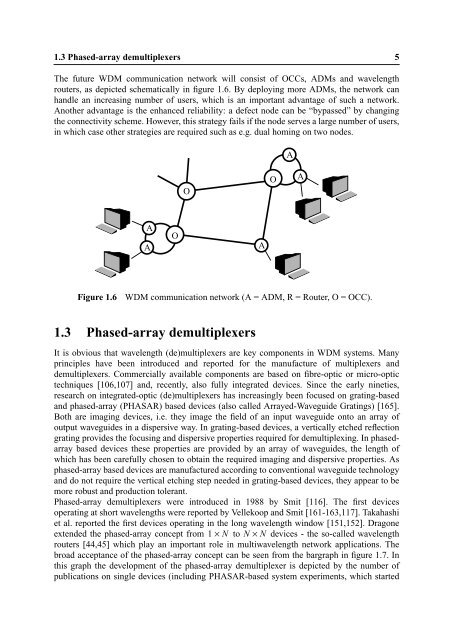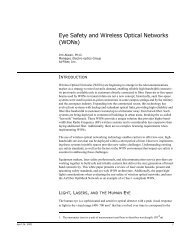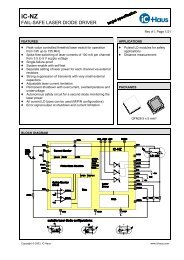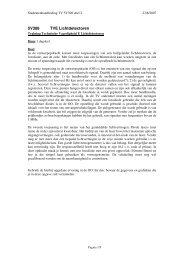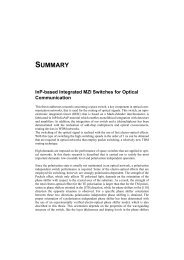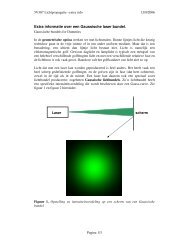InP-based polarisation independent wavelength demultiplexers
InP-based polarisation independent wavelength demultiplexers
InP-based polarisation independent wavelength demultiplexers
Create successful ePaper yourself
Turn your PDF publications into a flip-book with our unique Google optimized e-Paper software.
1.3 Phased-array <strong>demultiplexers</strong> 5<br />
The future WDM communication network will consist of OCCs, ADMs and <strong>wavelength</strong><br />
routers, as depicted schematically in figure 1.6. By deploying more ADMs, the network can<br />
handle an increasing number of users, which is an important advantage of such a network.<br />
Another advantage is the enhanced reliability: a defect node can be “bypassed” by changing<br />
the connectivity scheme. However, this strategy fails if the node serves a large number of users,<br />
in which case other strategies are required such as e.g. dual homing on two nodes.<br />
A<br />
A<br />
1.3 Phased-array <strong>demultiplexers</strong><br />
O<br />
O<br />
Figure 1.6 WDM communication network (A = ADM, R = Router, O = OCC).<br />
It is obvious that <strong>wavelength</strong> (de)multiplexers are key components in WDM systems. Many<br />
principles have been introduced and reported for the manufacture of multiplexers and<br />
<strong>demultiplexers</strong>. Commercially available components are <strong>based</strong> on fibre-optic or micro-optic<br />
techniques [106,107] and, recently, also fully integrated devices. Since the early nineties,<br />
research on integrated-optic (de)multiplexers has increasingly been focused on grating-<strong>based</strong><br />
and phased-array (PHASAR) <strong>based</strong> devices (also called Arrayed-Waveguide Gratings) [165].<br />
Both are imaging devices, i.e. they image the field of an input waveguide onto an array of<br />
output waveguides in a dispersive way. In grating-<strong>based</strong> devices, a vertically etched reflection<br />
grating provides the focusing and dispersive properties required for demultiplexing. In phasedarray<br />
<strong>based</strong> devices these properties are provided by an array of waveguides, the length of<br />
which has been carefully chosen to obtain the required imaging and dispersive properties. As<br />
phased-array <strong>based</strong> devices are manufactured according to conventional waveguide technology<br />
and do not require the vertical etching step needed in grating-<strong>based</strong> devices, they appear to be<br />
more robust and production tolerant.<br />
Phased-array <strong>demultiplexers</strong> were introduced in 1988 by Smit [116]. The first devices<br />
operating at short <strong>wavelength</strong>s were reported by Vellekoop and Smit [161-163,117]. Takahashi<br />
et al. reported the first devices operating in the long <strong>wavelength</strong> window [151,152]. Dragone<br />
extended the phased-array concept from 1 × N to N ×<br />
N devices - the so-called <strong>wavelength</strong><br />
routers [44,45] which play an important role in multi<strong>wavelength</strong> network applications. The<br />
broad acceptance of the phased-array concept can be seen from the bargraph in figure 1.7. In<br />
this graph the development of the phased-array demultiplexer is depicted by the number of<br />
publications on single devices (including PHASAR-<strong>based</strong> system experiments, which started<br />
A<br />
O<br />
A<br />
A


